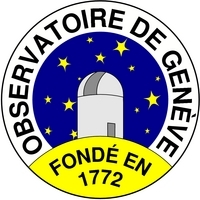
| INTEGRALPlanckGaiaPOLARCHEOPSEuclidATHENA |
| HEAVENSFACTCTALOFTSPICAJEM-EUSOXIPEeXTPTheseus |
| XRISMMAGBOUNDSMARTNet |
| ISDCCDCI |
| Data Centre for Astrophysics Astronomy Department of the University of Geneva |
Origin of the X-ray off-states in Vela X-1
| INTEGRAL discovered huge hard X-ray variability and off-sates in Vela X-1 and other high mass X-ray binaries. Hydrodynamic simulations allowed us to discover the likely source for such variations occuring on time scales of hours. These variations are related to oscillations of the accretion rate (with a typical period of ∼ 6800 sec) corresponding to the complex motion of a bow shock forming between the neutron star and the massive companion, moving either towards or away from the neutron star. |
|---|
ABSTRACT
Vela X-1 is the prototype of the classical sgHMXB systems. Recent continuous and long monitoring campaigns revealed a large hard X-rays variability amplitude with strong flares and off-states. This activity has been interpreted invoking clumpy stellar winds and/or magnetic gating mechanisms. We are probing if the observed behaviour could be explained by unstable hydrodynamic flows close to the neutron star rather than the more exotic phenomena. We have used the hydrodynamic code VH-1 to simulate the flow of the stellar wind with high temporal resolution and to compare the predicted accretion rate with the observed light-curves. The simulation results are similar to the observed variability. Off-states are predicted with a duration of 5 to 120 minutes corresponding to transient low density bubbles forming around the neutron star. Oscillations of the accretion rate with a typical period of ∼ 6800 sec are generated in our simulations and observed. They correspond to the complex motion of a bow shock, moving either towards or away from the neutron star. Flares are also produced by the simulations up to a level of 1037 erg/s. We have qualitatively reproduced the hard X-ray variations observed in Vela X-1 with hydrodynamic instabilities predicted by a simple model. More sophisticated phenomena, such as clumpy winds or the magnetic gating mechanism, are not excluded but not required to explain the basic phenomenology.
| by Roland Walter on 2014-12-22 | >> INTEGRAL science results | >> All science results |







